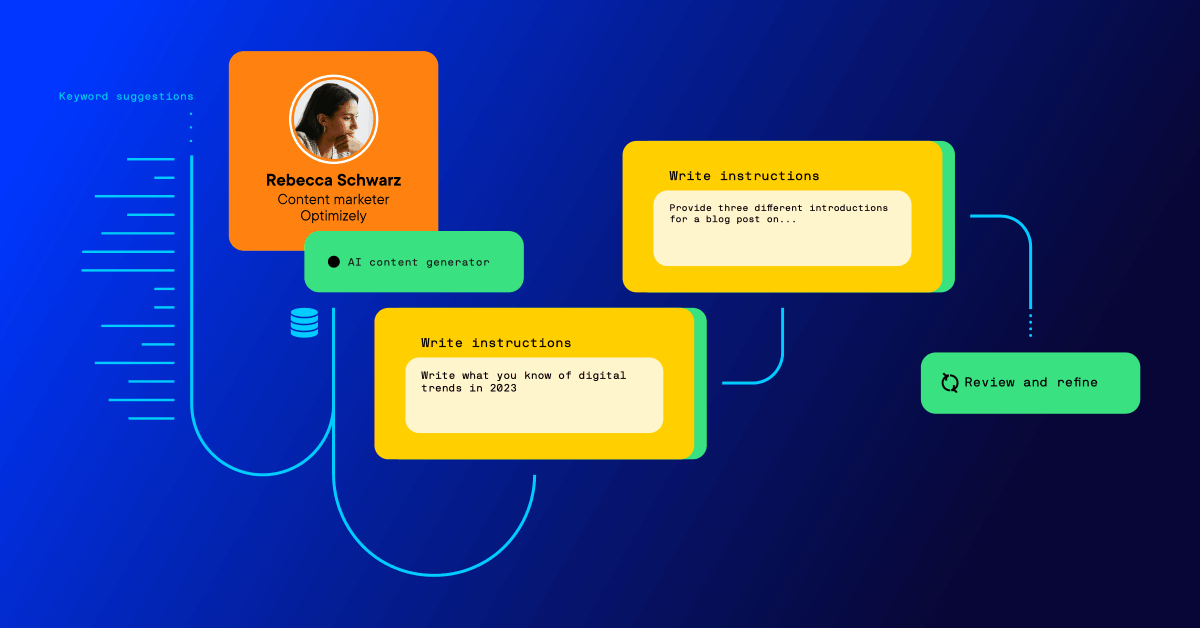8 tips for using AI to create the high-quality content your audience deserves


If the relentless appetite of modern audiences isn’t keeping you up at night, you’re probably not a content creator. It’s a reflection of the times we live in: hyperconnectivity coupled with digital platforms that are unapologetically designed to addict their user base. Audiences expect more... and more… and more… by the day, by the minute, sometimes even by the second. It’s a challenge of exponential velocity—a challenge that weighs heavily on today’s marketers to produce fresh, engaging content at rates they never dreamt possible.
And so, the verdict is clear: content marketers who don’t take advantage of AI-generated content tools to maintain velocity will trail the wake of those that do. But the content marketers who know how to use AI to enhance their content creation efforts—not just in quantity but also in quality—will be the ultimate victors. What’s the point of a loaded editorial calendar if it lacks the quality your audience deserves?
In this article, we’ll delve into 8 ways that AI content generators can help expedite your content creation processes while also meeting standards that will engage and resonate with your target audience.
1. Audience research
Understanding your audience is a necessary first step for crafting content that truly resonates, and AI can help provide information about specific target personas—not just basic demographics, but also psychographic information on their behaviors and preferences.
Break down your target audience into individual personas and ask your AI content generator questions that add more color around who they are and what they care about. You can even use this as a jumping point for deeper research. For example:
- What’s their average age?
- What do they do in their day-to-day role?
- What are their biggest challenges and pain points?
- What do they care about most?
- What do they want to achieve?
- What is their success measured against?
- What are their preferred content formats?
- Where do they go to find helpful guidance and information?
- What are some common tools they regularly use?
- What are their values, beliefs, hobbies, or habits?
2. Keyword research for SEO
Now that you have a better understanding of your target personas, AI can go a long way to help improve search rankings. AI content generators can analyze large amounts of data from search engines, social media, and online platforms to generate relevant and targeted keyword suggestions. They can also identify long-tail keywords, search intent, semantic variations, contextually related terms, and keyword clusters to help you optimize content for a broader range of search queries.
To take things one step further, AI content generators can perform competitive analysis to identify keywords that competitors are ranking for. Understanding the keywords that drive traffic to competing websites will help you identify gaps in your own content strategy and discover new keyword opportunities.
3. Trending topics for content ideation
Content marketing thrives on relevance, and keeping up with trending topics can be a time-consuming process. By analyzing data from diverse digital sources—be it social media platforms, blogs, news sites, or forums—AI can help identify emerging patterns and topics that are gaining traction. This real-time analysis helps keep you updated on what your audience is currently interested in to swiftly adapt your content strategy.
But it doesn’t stop there. AI can also provide preliminary drafts or suggest content angles on these trending topics. With the ability to analyze previously successful content structures and the specific interests of a brand's audience, AI can recommend approaches that are more likely to resonate.
4. Background research on not-so-familiar topics
They say write what you know but what if you don’t know it all? Content marketers are often tasked with writing about a diverse array of topics, some of which they may not be intimately familiar with—but you no longer have to spend hours or even days trawling through multiple sources for foundational understanding. Use AI as your digital research assist—an efficient means to bridge the knowledge gap. Within moments, you’ll be presented with a comprehensive overview of any topic, highlighting key facets, historical context, contemporary relevance, and the latest data or insights associated with it.
But beyond just data retrieval, AI content generators can structure and present this information in a user-friendly manner. By analyzing the kind of content that resonates with readers in a given niche or industry, the AI can tailor its outputs, ensuring that even the densest of topics are made accessible and engaging. This not only ensures that your pieces are informed and accurate but also structured in a way that captures and retains reader interest.
5. Editorial calendar planning
Catering to diverse audience preferences across various formats—be it blogs, podcasts, videos, infographics, or social media posts—is crucial. And planning a comprehensive editorial calendar that spans these formats requires meticulous strategy, foresight, and a deep understanding of audience behavior. AI can understand patterns in audience engagement, preferences, and content consumption habits across different mediums. Based on these insights, an it can recommend a structured editorial calendar that strategically intersperses different content formats. For example, if the AI identifies that video content sees peak engagement on weekends, while long-form articles are consumed more during mid-week, it can schedule accordingly, ensuring that content is not just high-quality, but also timely.
An AI-driven editorial calendar doesn't just allocate formats based on broad trends, it tailors content topics for each format based on what has historically resonated best with target audiences. By analyzing metrics like shares, comments, and dwell time, the AI can discern which topics are best suited for video discussions, which ones make compelling infographics, and which are ripe for deep-dives in blog format. This intricate meshing of topic with format ensures that the content isn't just diverse but is also optimized for maximum engagement.
6. Content outlines
A robust content outline serves as the blueprint that guides overall flow, ensures comprehensiveness, and ensures all key points are addressed. Use AI to help you produce outlines based on any given topic, for any given content format. For varied marketing assets, whether they're whitepapers, articles, or video scripts, AI content generators can customize the outlines based on the specific nature and intent of the asset. Fore example: If you’re planning a webinar, AI can help suggest a format that balances visuals with key talking points. If you’re planning a detailed user guide, it might recommend an in-depth, sectioned approach with introductions, body content, and conclusions. Now you’ll have a tailor-made, strategic scaffold that ensures consistency across all produced content.
7. Content generation
Now we get to the good part: the actual generation of the actual content. The six tips before this are all building blocks that allow you to knock it out of the park when asking your AI tool to generate content. Because you get what you give, the secret to getting a great first draft from your content generator is to brief it how you’d personally like to be briefed. The more information, the better. Here’s a helpful start:
- Put the bot in your shoes: Prompt your AI by having them live a day in your life. This will generate content that’s more specific for what you’re trying to achieve. For example: “You’re a content marketer at Optimizely writing an article about a new product feature.”
- State the desired format: If you're writing for a particular content format, mention it. "Write a listicle on the benefits of organic SEO."
- Set the tone: If you want the content to carry a certain mood or tone, specify it. For instance, "Write a humorous guide on common email marketing blunders."
- Define the audience: Make sure to specify the target audience. For examples "Write an introduction to content marketing for small business owners."
- Limit your length: For more concise answers or to get a summary, indicate a desired word count or ask for a brief explanation.
- Ask open-ended questions: To extract more detailed and expansive answers, frame your prompts as open-ended questions.
- Provide context: The more background or context you give, the better the AI can tailor its response. If you're continuing from a previous topic or if there's a unique context to your request, mention it.
- Ask for multiple angles: If you’re unsure about the exact angle you want, you can ask the AI to provide multiple takes on a topic. For example: "Provide three different introductions for a blog post on digital marketing trends in 2023."
- Review and refine: AI is a tool, and its outputs will always need human touch-ups. Once you get the content, review it for alignment with brand voice, accuracy, and relevance. The output can be an excellent starting point that you can then refine to perfection.
8. Content refinement
Existing marketing content can sometimes lose its relevance or impact as market dynamics, audience preferences, and keyword trends evolve. AI can help analyze a piece of content and cross-reference it with current keyword trends, search intents, and audience behavior patterns. For example, an older blog post might have solid foundational information but may lack recent keywords that have gained prominence. Your AI content generator is also great at identifying gaps or outdated information. It can recommend additions or modifications, breathing new life into your content arsenal.
